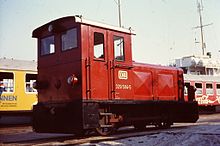DB class 329
| Class 329 Class 399 101-104 |
|||
|---|---|---|---|

|
|||
| number | 1 | 2 | 1 |
| numbering | V 11 901, Köf 99 501, 329 501 |
V 11 902-903, Köf 99 502-503, 329 502-503 |
329 504 |
| Manufacturer | Gmeinder | KHD | |
| Commissioning | 1952 | 1956 | 1952, at DB 1971 |
| Retirement | 1999 | ||
| Axis formula | C. | B. | |
| Service weight | 16.5 t | 13 t | |
| overall length | 5,566 mm | 6,090 mm | |
| height | 2,800 mm | 2,880 mm | |
| width | 2,030 mm | 2,600 mm | 2,100 mm |
| Wheel diameter | 700 mm | 820 mm | |
| Wheelbase | 900 mm | 2,700 mm | |
| Total axle base | 1,800 mm | 2,700 mm | |
| Gauge | 1,000 mm | ||
| Engine type | A6M 617 | ||
| Number of engines | 1 | ||
| drive | Diesel engine with hydraulic transmission | ||
| power | 96 kW | ||
| rotational speed | 1,500 rpm | ||
| Top speed | 20 km / h | ||
| brake | Hand spindle | ||
The class 329 was the name given to the narrow-gauge small locomotives of the Wangeroog Island Railway on the Deutsche Bundesbahn . In total, the series comprised four locomotives in three different but very similar designs.
329 501
The first of the four machines was manufactured by Gmeinder in 1952 as a further development of the three-axle HF 130 C (type designation HK 130 C) and delivered to the DB under the designation V 11 901 . This series designation corresponded to the designation scheme at that time, as the locomotive, similar to the Köf III, was initially not classified as a small locomotive due to its output of 130 PS (96 kW) . The locomotive had an outer frame. A hydrodynamic drive by the company Voith was blind shaft driven, who was sitting directly under the cab. From there, an external drive rod led to the central axis, which in turn was connected to the other two axes by coupling rods. All axles and the jackshaft had external counterweights. The locomotive had a well-proven KHD engine. At the beginning of the 1960s, the driver's cab was modernized and fitted with new doors and windows.
The locomotive was sold to the Stiftung Deutsche Kleinbahnen, which re-gauged it to 600 mm and used it on the De Lütt coffee maker at Klütz .
329 502 to 503
After the delivery of two more machines in slightly different designs, again from Gmeinder, the series designation changed in 1957 from V 11 to V 99, the serial numbers changed from 901–903 to 501–503. The series change made it clear that these were narrow-gauge locomotives. Technically, these locomotives largely corresponded to their predecessors, but the structure had more rounded shapes and the driver's cab was significantly wider at 2.6 m. With the delivery of the two new locomotives, the last steam locomotives on the island railway could also be parked. A year later, the three locomotives were finally redesignated as small locomotives under the designation Köf 99 501-503 .
According to the DB series scheme , the three narrow-gauge locomotives were also given UIC- compliant seven-digit, computer-readable numbers in 1968 ; the 329 series was selected and the previous serial numbers were retained.
329 504
The series received further growth in 1971 when a two-axle locomotive built by Klöckner-Humboldt-Deutz in 1952 was initially taken over on loan from the DB for the Wangerooger Bahn by Inselbahn Juist (locomotive: "Heinrich" ). A year later, the machine, which had meanwhile been referred to as 329 504-5, was finally bought by the DB. Here, too, the drive was carried out by a KHD motor via a Voith gearbox with integrated reversing gear on a jackshaft. This sat between the two axles, both of which were driven by the jackshaft. Thanks to the inner frame, no external counterweights were necessary. For use on Wangerooge, some changes were necessary, such as the installation of the balancing lever coupling and a three-light peak signal.
business
In the years that followed, the four machines handled the entire operation on the island railway, with a draisine only available for business trips . In 1981 a railcar from the Spiekerooger Inselbahn was added, which replaced the locomotive-hauled trains when there was little passenger traffic and was given the number 699 001 .
With the introduction of a Germany-wide numbering system in connection with the planned merger of DB and DR , the four locomotives (as well as all narrow-gauge small locomotives of the Deutsche Reichsbahn ) were designated as class 399 from 1992 , the Wangeroog machines were given the numbers 399 101-104. At the end of 1992, the DB procured two more small locomotives from the Romanian manufacturer FAUR from the former Mansfeld combine in Helbra to support the rather old machines . However, these did not meet the expectations placed on them and have only rarely been used since then. The former class 329 was finally replaced with the delivery of two new locomotives ( 399 107 and 108 ) from Schöma , which took over the entire traffic with the support of the two FAUR machines.
The four old locomotives were then parked and sold to a private railway company, who kept all four machines inaccessible in a hall near Prora on Rügen.
literature
- Egbert Nolte: The Wangerooger Inselbahn. Kenning Verlag, Nordhorn 1999, ISBN 3-933613-07-8 .
- Malte Werning: Wangerooge: The island railway and its history. Lokrundschau Verlag, Gülzow 1999, ISBN 3-931647-09-9 .

